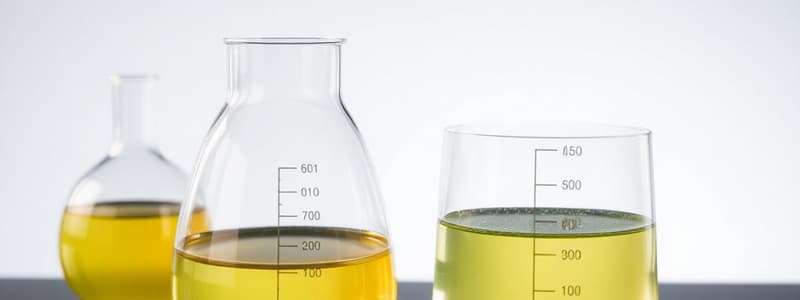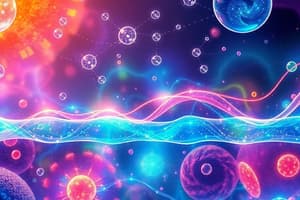Podcast
Questions and Answers
Which acid has the highest acidity based on its Ka value?
Which acid has the highest acidity based on its Ka value?
- Hydrogensulphate ion (Ka = 1.2 x 10^-2)
- Ethanoic acid (Ka = 1.8 x 10^-5)
- Carbonic acid (Ka = 4.2 x 10^-7)
- Sulphuric acid (Ka is very large) (correct)
What is the pKa value of Carbonic acid, given that Ka = 4.2 x 10^-7?
What is the pKa value of Carbonic acid, given that Ka = 4.2 x 10^-7?
- 6.38 (correct)
- 5.38
- 7.38
- 4.38
Which of the following statements is true regarding pKa and acid strength?
Which of the following statements is true regarding pKa and acid strength?
- pKa does not correlate with acid strength.
- A higher pKa value indicates a stronger acid.
- All acids have the same pKa value.
- Lower pKa values represent stronger acids. (correct)
How does the dissociation of polyprotic acids differ from monoprotic acids?
How does the dissociation of polyprotic acids differ from monoprotic acids?
What makes the second deprotonation of sulphuric acid (HSO4-) more difficult than the first?
What makes the second deprotonation of sulphuric acid (HSO4-) more difficult than the first?
What range of pH is optimal for a buffer solution to be effective?
What range of pH is optimal for a buffer solution to be effective?
What is the primary factor influencing the amount of ionization of drug molecules?
What is the primary factor influencing the amount of ionization of drug molecules?
How does the Henderson-Hasselbalch equation relate pH to pKa?
How does the Henderson-Hasselbalch equation relate pH to pKa?
For which pH level is a phosphate buffer appropriate, given its pKa of 7.21?
For which pH level is a phosphate buffer appropriate, given its pKa of 7.21?
What is the buffer capacity of a solution?
What is the buffer capacity of a solution?
What will happen to the absorption of a drug if it is in its ionized form in the stomach?
What will happen to the absorption of a drug if it is in its ionized form in the stomach?
At what point is a drug most likely to be absorbed effectively in the gastrointestinal tract?
At what point is a drug most likely to be absorbed effectively in the gastrointestinal tract?
Which statement is true regarding the relationship between pKa and pH for a weak acid?
Which statement is true regarding the relationship between pKa and pH for a weak acid?
What distinguishes a strong acid from a weak acid?
What distinguishes a strong acid from a weak acid?
Which of the following statements is true regarding conjugate acids and bases?
Which of the following statements is true regarding conjugate acids and bases?
What is the primary role of water in the equilibrium NH3 + H2O ↔ NH4+ + OH-?
What is the primary role of water in the equilibrium NH3 + H2O ↔ NH4+ + OH-?
What is the function of the equilibrium constant Ka?
What is the function of the equilibrium constant Ka?
How is the acidity of a weak acid related to its pKa value?
How is the acidity of a weak acid related to its pKa value?
Which equation correctly describes the relationship between pKa and pKb?
Which equation correctly describes the relationship between pKa and pKb?
What is depicted by the equilibrium constant Kb?
What is depicted by the equilibrium constant Kb?
What implication does a 0.00001M solution of HCl have?
What implication does a 0.00001M solution of HCl have?
Which of the following statements is accurate concerning strong and weak bases?
Which of the following statements is accurate concerning strong and weak bases?
In the reaction of acetic acid with water, what is the conjugate base formed?
In the reaction of acetic acid with water, what is the conjugate base formed?
Flashcards
pKa of Acetic Acid
pKa of Acetic Acid
The pH at which half of the acetic acid molecules are protonated (ionized), a measure of its acidity.
Henderson-Hasselbalch Equation
Henderson-Hasselbalch Equation
An equation that relates the pH of a buffer solution to the pKa of the acid and the ratio of the concentrations of the conjugate base and acid.
Buffer Capacity (b)
Buffer Capacity (b)
The amount of acid or base that can be added to a buffer solution without a significant change in pH.
Optimal Buffer pH Range
Optimal Buffer pH Range
Signup and view all the flashcards
Phosphate Buffer
Phosphate Buffer
Signup and view all the flashcards
Drug Absorption
Drug Absorption
Signup and view all the flashcards
Unionized Drug Form
Unionized Drug Form
Signup and view all the flashcards
pH Partition Hypothesis
pH Partition Hypothesis
Signup and view all the flashcards
Acid Strength
Acid Strength
Signup and view all the flashcards
pKa
pKa
Signup and view all the flashcards
Polyprotic Acid
Polyprotic Acid
Signup and view all the flashcards
Deprotonation
Deprotonation
Signup and view all the flashcards
Strong Acid Dissociation
Strong Acid Dissociation
Signup and view all the flashcards
Strong Acid
Strong Acid
Signup and view all the flashcards
Weak Acid
Weak Acid
Signup and view all the flashcards
Conjugate Base
Conjugate Base
Signup and view all the flashcards
Conjugate Acid
Conjugate Acid
Signup and view all the flashcards
Acidity Constant (Ka)
Acidity Constant (Ka)
Signup and view all the flashcards
Basicity Constant (Kb)
Basicity Constant (Kb)
Signup and view all the flashcards
Relationship between Ka and Kb
Relationship between Ka and Kb
Signup and view all the flashcards
pKa + pKb = 14
pKa + pKb = 14
Signup and view all the flashcards
Study Notes
Acids & Bases, pH and Buffers
- Blood pH levels range from 6 to 9, with 7.35-7.45 being the normal range; values outside this range indicate acidosis (low pH) or alkalosis (high pH).
- Death can result from severe acidosis or alkalosis, as biochemical reactions are sensitive to pH.
- Buffer solutions maintain a constant pH in biological systems, crucial for proper bodily function. Examples include saliva, sweat, blood, stomach, intestine, and urine.
- The pH scale is logarithmic, meaning pH values change by powers of 10 (e.g., pH 1 is 10 times more acidic than pH 2).
- The pH scale ranges from 0 to 14, with neutral pH = 7.
- pH = -log[H+]
- pOH = -log[OH-]
- Kw= [H+][OH-] = 1 x 10-14
Learning Outcomes
- Students should be able to explain acids, bases, pH, and pOH.
- Students should be able to define strong and weak acids and their importance in biology.
- Students should understand water auto-ionization.
- Students should know about conjugate acid/base pairs (Ka, Kb, pKa, pKb)
- Students should be able to calculate pH.
- Students should explain buffer systems and the factors affecting choice of buffer, using the Henderson-Hasselbalch equation. and perform buffer calculations.
Suggested Reading
- Crowe & Bradshaw, Chemistry for the Biosciences, 3rd Edition (e-book in online library)
- "Catch up Chemistry" (online resource)
- Chapter 17: "Acids, bases and buffer solutions"
Biochemical Reactions in the Body
- Biochemical reactions in the body are highly sensitive to pH.
- Buffer solutions are crucial for maintaining this pH, and this includes saliva, sweat, blood, stomach, intestines, and urine.
Acids and Bases
- Electrolytes, upon addition to water, dissociate into cations and anions.
- Brønsted-Lowry Acid is a proton donor (HA → H+ + A–).
- Brønsted-Lowry Base is a proton acceptor (B + H+ → BH+).
- Autoionization is a reaction between identical neutral molecules to form a cation and an anion (e.g., 2H2O ⇌ H3O+ + OH-, Kw = [H+][OH-]).
Equilibrium Constants
- For any reversible reaction with reactants A & B and products C & D, the equilibrium constant is Keq = [C][D]/[A][B].
- The water equilibrium is a reverse reaction (2H₂O ⇌ H₃O+ + OH–), which lies predominantly to the left, implying a small degree of dissociation.
- The equilibrium constant for water dissociation, Kw, is [H+][OH-]/[H2O]. However, the water concentration is assumed to be constant, therefore Kw = [H+][OH-) = 1 x 10-14 M2.
pH
pH scale is a logarithmic scale expressing the concentration of H+ ions in solution.
Calculating pH
- pH = -log[H+].
Strong/Weak Acids/Bases
- Strong acids completely dissociate in solution, while weak acids only partially dissociate.
- Strong bases completely dissociate in solution, while weak bases only partially dissociate.
- Note: the strength of an acid or base is not dependent on concentration, but rather the equilibrium constant and pK values.
Conjugate Acids and Bases
- A conjugate base is what remains of an acid after it has donated a proton.
- Weak acid dissociates to give H+ and its conjugate base.
- E.g. CH3COOH + H2O ⇌ H3O+ + CH3COO- conjugate base.
- A conjugate acid is formed when a base accepts a proton.
- E.g. NH3 + H2O ⇌ NH4+ + OH-.
Acid Equilibrium Constant
- Ka = [H3O+][A-]/[HA]
Base Equilibrium Constant
- Kb = [BH+][OH-]/[B]
pKa, pKb
- pKa = -logKa
- pKb = -logKb
Polyprotic Acids
- Polyprotic acids can donate more than one proton (e.g., H2SO4, H3PO4).
- Each dissociation step has its own equilibrium constant.
Buffers
- Buffer solutions resist changes in pH when an acid or base is added.
- Often contain substances with acidic and basic forms (Conjugate pairs of weak acids).
- The Henderson-Hasselbalch equation gives the relationship between pH, pKa, and the concentrations of the acid and its conjugate base. pH = pKa + log[base]/[acid].
- Buffers work best around a pH range of ±1 of their pKa.
Choice of Buffer Solution
- The choice of a buffer solution depends on the desired pH range. Biological fluids commonly use a phosphate buffer as it works well at slightly above neutral pH (e.g pH 7).
Acids & Bases in Biological Systems
- Many biological processes require specific pH levels.
- For example, the small intestine has a pH of around 6, to ensure proper functioning of digestive enzymes and absorption of nutrients.
- The pH of the stomach is extremely low (1 to 2) to help break down food.
- Certain drugs must be in a non-ionized form to be absorbed through cell membranes.
- pKa's and ionisation play key roles in medicine absorption; for example, aspirin is better absorbed in the stomach.
Studying That Suits You
Use AI to generate personalized quizzes and flashcards to suit your learning preferences.




